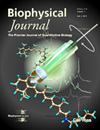Spatial Charge-Hydrophobicity Configuration Modulates Cationic Peptide Transport in Cartilage.
IF 3.1
3区 生物学
Q2 BIOPHYSICS
引用次数: 0
Abstract
Charge-based delivery systems offer a promising approach for targeting dense, negatively charged tissues such as cartilage, which presents a significant transport barrier due to its high fixed charge density (FCD) from aggrecan glycosaminoglycans (GAGs). Cationic nano-carriers, including peptide-based systems, can overcome these barriers by leveraging electrostatic interactions to enhance intra-tissue penetration. However, the effectiveness of these carriers depends not only on their net positive charge, which drives Donnan partitioning, but also on the precise spatial arrangement of cationic and hydrophobic residues, which influences transport, binding, and retention. In this study, we investigated the impact of spatial charge distribution and hydrophobicity on the intra-cartilage transport and retention of arginine-rich cationic peptide carriers (CPCs) with a net charge of +14, optimized for effective cartilage targeting. Using both experimental methods and molecular modeling, we examined the transport properties of CPCs with varied charge and hydrophobic cluster arrangements in healthy and degenerated cartilage with different FCDs. Our findings reveal that peptides with a higher degree of clustered cationic or hydrophobic residues exhibit greater intra-cartilage diffusivity due to weaker binding interactions with aggrecan GAGs and a more flexible structural conformation that incurs an entropic penalty. However, while hydrophobic residues can enhance intra-tissue retention, particularly in degenerated tissues, they also promote competitive binding within synovial fluid (SF), emphasizing the need for hydrophilic designs. Overall, our results indicate that evenly distributed cationic residues and minimal hydrophobicity yield the most effective carriers for deep, long-term tissue penetration, providing a framework for the rational design of tissue-targeting cationic peptide carriers. The design principles established in this work can be broadly applied to the rational development of cationic carriers for targeted drug delivery in a wide range of negatively charged tissues.空间疏电结构调节软骨中阳离子肽的转运。
基于电荷的递送系统为靶向致密、带负电荷的组织(如软骨)提供了一种很有前途的方法,软骨由于其来自聚集蛋白糖胺聚糖(GAGs)的高固定电荷密度(FCD)而呈现出显著的运输障碍。阳离子纳米载体,包括基于肽的系统,可以通过利用静电相互作用来增强组织内渗透来克服这些障碍。然而,这些载体的有效性不仅取决于它们的净正电荷,这驱动了Donnan分配,还取决于阳离子和疏水残基的精确空间排列,这影响了运输、结合和保留。在这项研究中,我们研究了空间电荷分布和疏水性对富含精氨酸的阳离子多肽载体(CPCs)软骨内运输和保留的影响,CPCs的净电荷为+14,优化为有效的软骨靶向。利用实验方法和分子模型,我们研究了不同电荷和疏水簇排列的cpc在不同fcd的健康和变性软骨中的运输特性。我们的研究结果表明,具有更高程度的簇化阳离子或疏水残基的肽,由于与聚集蛋白GAGs的结合相互作用较弱,并且具有更灵活的结构构象,从而导致熵罚,因此表现出更大的软骨内扩散性。然而,虽然疏水残基可以增强组织内保留,特别是在变性组织中,但它们也促进滑液(SF)内的竞争结合,强调了亲水设计的必要性。总体而言,我们的研究结果表明,均匀分布的阳离子残基和最小的疏水性产生了深入、长期渗透组织的最有效载体,为合理设计组织靶向阳离子肽载体提供了框架。在这项工作中建立的设计原则可以广泛应用于合理开发阳离子载体,用于在各种带负电的组织中靶向递送药物。
本文章由计算机程序翻译,如有差异,请以英文原文为准。
求助全文
约1分钟内获得全文
求助全文
来源期刊

Biophysical journal
生物-生物物理
CiteScore
6.10
自引率
5.90%
发文量
3090
审稿时长
2 months
期刊介绍:
BJ publishes original articles, letters, and perspectives on important problems in modern biophysics. The papers should be written so as to be of interest to a broad community of biophysicists. BJ welcomes experimental studies that employ quantitative physical approaches for the study of biological systems, including or spanning scales from molecule to whole organism. Experimental studies of a purely descriptive or phenomenological nature, with no theoretical or mechanistic underpinning, are not appropriate for publication in BJ. Theoretical studies should offer new insights into the understanding ofexperimental results or suggest new experimentally testable hypotheses. Articles reporting significant methodological or technological advances, which have potential to open new areas of biophysical investigation, are also suitable for publication in BJ. Papers describing improvements in accuracy or speed of existing methods or extra detail within methods described previously are not suitable for BJ.
 求助内容:
求助内容: 应助结果提醒方式:
应助结果提醒方式:


